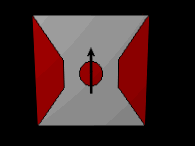
Materials Research Science and Engineering Center: Faculty Publications
Document Type
Article
Date of this Version
May 2003
Abstract
We report results of first-principles density-functional studies of the atomic and electronic structure of Co/Al2O3/Co and Co/SrTiO3/Co magnetic tunnel junctions (MTJs). The atomic structure has been studied for different interface terminations and the interfacial energetics was quantified based on the work of separation. Based on energetics of cohesion, the O-terminated and TiO2-terminated interfaces were identified as the most stable structures for Co/Al2O3/Co and Co/SrTiO3/Co MTJs, respectively. The electronic structure was analyzed using local densities of states. We found that the electronic structure of the O-terminated Co/Al2O3/Co tunnel junction exhibits negative spin polarization at the Fermi energy within the first few monolayers of alumina but it eventually becomes positive for distances beyond 10 Å. Calculated electronic structure of the TiO2-terminated Co/SrTiO3/Co MTJ shows an exchange coupling between the interface Co and Ti atoms mediated by oxygen. This coupling induces a magnetic moment of 0.25 µB on the interface Ti atom, which is aligned antiparallel to the magnetic moment of the Co layer. This is a possible cause of inversion of the spin polarization of tunneling across the SrTiO3 barrier that was found in recent experiments.


Comments
Published by American Institute of Physics. J. Applied Physics 93, 6429-6431 (2003). ©2003 American Institute of Physics. Permission to use. http://jap.aip.org/jap/.